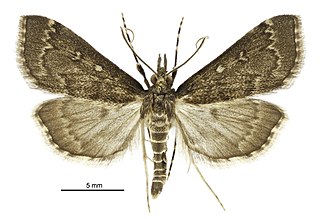
Proternia is a monotypic moth genus of the family Crambidae described by Edward Meyrick in 1884. Its only species, Proternia philocapna, described by the same author in the same year, is endemic to New Zealand.

Asterivora exocha is a species of moth in the family Choreutidae. It was first described by Edward Meyrick in 1907 and is endemic to New Zealand. This species has only been observed in the Humboldt Ranges of Otago and inhabits subalpine native bush at elevations of around 3600 ft. Adults of this species are on the wing in December and January and have been observed flying at dusk.
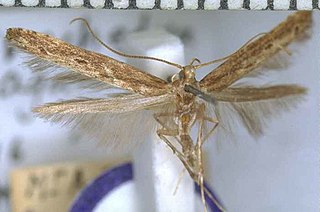
Batrachedra agaura is a species of moth in the family Batrachedridae. It is endemic to New Zealand. This species is distributed throughout the country. The species inhabits native forest especially beech and kanuka forest or manuka scrubland. The larvae of this species is associated with sooty mold and with sooty beech scale. It has been hypothesised that the larvae feed on sooty beech scale. However they may also feed on the sooty mold itself. The adult female is lighter in appearance than the male and the species shows considerable variation in patterns on forewing. Adults are on the wing from October to February. They are nocturnal and occasionally attracted to light.
Heterocrossa contactella is a species of moth in the family Carposinidae. It is endemic to New Zealand.
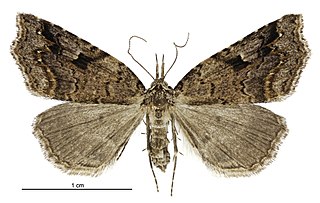
Trigonistis anticlina is a species of moth in the family Noctuidae. It is endemic to New Zealand. Adults of this species inhabit dense native forest habitat in ravines.

Pyrausta comastis is a moth in the family Crambidae. This species is endemic to New Zealand. It has been classified as "nationally vulnerable" by the Department of Conservation.

Eudonia meliturga is a moth in the family Crambidae. It was described by Edward Meyrick in 1905. This species is endemic to New Zealand.
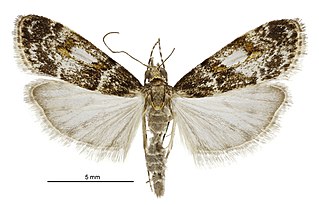
Eudonia thyridias is a moth in the family Crambidae. It was described by Edward Meyrick in 1905. It is endemic to New Zealand.
Hypatima isotricha is a species of moth in the family Gelechiidae. It was described by Edward Meyrick in 1921. It is found on Java in Indonesia.
Compsolechia eurygypsa is a moth of the family Gelechiidae. It was described by Edward Meyrick in 1922. It is found in Peru.
Compsolechia loxogramma is a moth of the family Gelechiidae. It was described by Edward Meyrick in 1922. It is found in Amazonas, Brazil.
Antaeotricha sparganota is a moth of the family Depressariidae first described by Edward Meyrick in 1915. It is found in Guyana.
Epichostis antigama is a moth in the family Xyloryctidae. It was described by Edward Meyrick in 1908. It is found in southern India.
Gonionota oriphanta is a moth in the family Depressariidae. It was described by Edward Meyrick in 1928. It is found in Colombia.
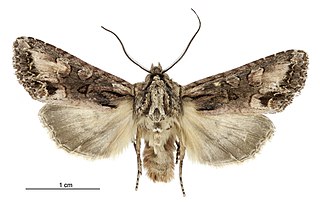
Ichneutica bromias is a moth of the family Noctuidae. This species is endemic to the Chatham Islands of New Zealand where is found on the Chatham, Pitt and Rangatira Islands. This species is similar in appearance to Ichneutica mutans but is darker and duller in its overall appearance. However, as I. mutans is not present in the Chathams this similarity is unlikely to cause confusion. The adults of the species are on the wing from November to March. The life history and the larval host species are unknown.
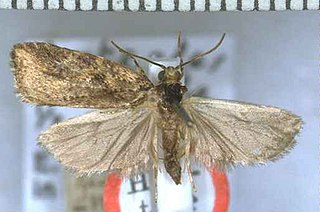
Proteodes profunda is a species of moth in the family Depressariidae. It is endemic to New Zealand. This species has been collected in its type locality of Mount Holdsworth in the Tararua Range, Raurimu near Tongariru National Park, Days Bay in Wellington, Mount Arthur, Otira, Invercargill, and in Southland. P. profunda lives in beech forests at altitudes of around 2000 ft and larvae feed on beech tree leaves. Adults of this species are on the wing from November to February.

Tingena crotala is a species of moth in the family Oecophoridae. It is endemic to New Zealand and is found both in the North and South Islands. This species inhabits native forest and is on the wing in November and December.

Tingena hemimochla is a species of moth in the family Oecophoridae. It is endemic to New Zealand and has been observed in the North Island. Adults of this species are on the wing from December until March.

Tingena penthalea is a species of moth in the family Oecophoridae. It is endemic to New Zealand and has been observed in Wellington and the Tararua Range. The adults of this species are on the wing from December until February.
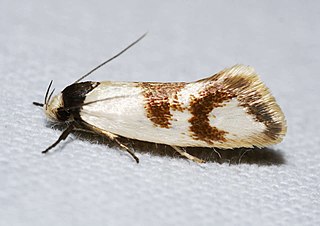
Antipterna trilicella is a species of moth in the family Oecophoridae, first described by Edward Meyrick in 1885 as Ocystola trilicella. It appears to be a moth endemic to Australia and confined to the east coast, occurring in Victoria, New South Wales and Queensland.












